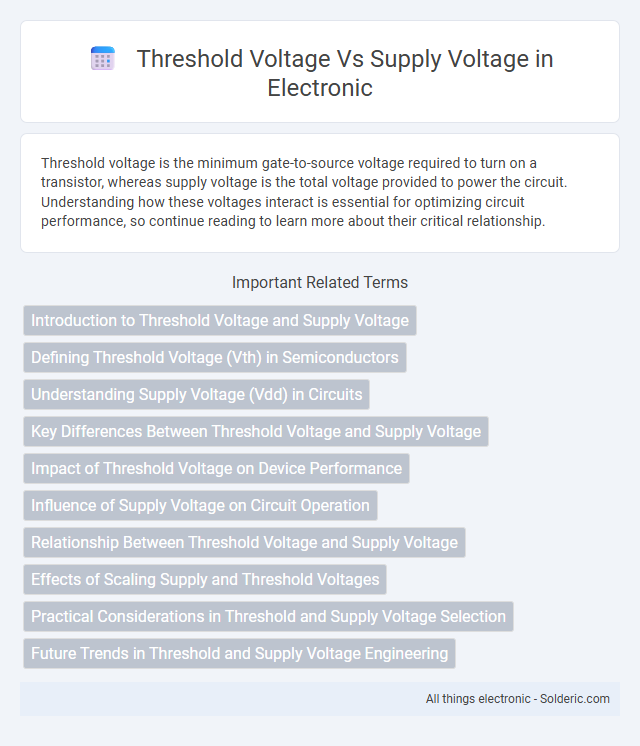Threshold voltage is the minimum gate-to-source voltage required to turn on a transistor, whereas supply voltage is the total voltage provided to power the circuit. Understanding how these voltages interact is essential for optimizing circuit performance, so continue reading to learn more about their critical relationship.
Comparison Table
| Parameter | Threshold Voltage (VT) | Supply Voltage (VDD) |
|---|---|---|
| Definition | The minimum gate-to-source voltage required to create a conducting path between source and drain in a MOSFET. | The voltage provided to power an electronic circuit or device. |
| Role | Controls transistor switching behavior and leakage current. | Determines the operating voltage range and performance of circuits. |
| Typical Values | 0.2 V to 1 V (depends on technology and device type). | 1 V to 5 V (varies by device and application). |
| Impact on Power Consumption | Lower VT reduces delay but increases leakage power. | Higher VDD increases dynamic power consumption. |
| Effect on Performance | Directly affects transistor switching speed and noise margin. | Higher VDD generally improves circuit speed. |
| Adjustment | Set during fabrication via doping and processing. | Configured externally to the device, often by power supply design. |
| Dependence | Intrinsic property of the transistor device. | External parameter controlling circuit operation. |
Introduction to Threshold Voltage and Supply Voltage
Threshold voltage (Vth) is the minimum gate-to-source voltage required to create a conductive channel in a MOSFET, enabling current flow between the source and drain terminals. Supply voltage (Vdd) refers to the external voltage provided to power an electronic circuit, determining the maximum operational voltage of devices within the system. Understanding the relationship between threshold voltage and supply voltage is critical for optimizing circuit performance, power consumption, and transistor switching behavior.
Defining Threshold Voltage (Vth) in Semiconductors
Threshold voltage (Vth) in semiconductors is the critical gate-to-source voltage at which a MOSFET begins to conduct significant current, marking the transition between the off state and the on state in transistor operation. Supply voltage (Vdd) typically exceeds the threshold voltage, enabling the transistor to switch fully on and ensuring effective digital circuit performance. Precise control of Vth relative to Vdd is essential for minimizing leakage currents and optimizing power efficiency in integrated circuits.
Understanding Supply Voltage (Vdd) in Circuits
Supply voltage (Vdd) is the critical power level that drives integrated circuits, directly influencing the transistor switching speed and overall circuit performance. Threshold voltage (Vth) is the minimum gate-to-source voltage required to create a conductive channel in a MOSFET, and its relation to Vdd determines the noise margin and power consumption. Optimizing the ratio of Vdd to Vth is essential for balancing speed, stability, and energy efficiency in modern low-power electronic designs.
Key Differences Between Threshold Voltage and Supply Voltage
Threshold voltage (Vth) is the minimum gate-to-source voltage required to create a conductive channel in a MOSFET, determining when the transistor switches from off to on state. Supply voltage (Vdd) is the voltage provided to power an electronic circuit, defining the maximum voltage available for transistor operation. Unlike supply voltage, threshold voltage is a device-specific parameter critical for controlling transistor switching behavior, impacting power consumption and switching speed.
Impact of Threshold Voltage on Device Performance
Threshold voltage (Vth) directly influences the switching speed and power consumption of semiconductor devices, as a higher Vth reduces leakage current but increases delay time, while a lower Vth improves switching speed at the cost of higher standby power. Variations in threshold voltage can affect the noise margin and overall stability of CMOS circuits, impacting device performance under different supply voltage levels. Adjusting Vth relative to supply voltage (Vdd) enables optimization of gain, drive current, and energy efficiency in transistors, crucial for low-power and high-speed applications.
Influence of Supply Voltage on Circuit Operation
The threshold voltage (Vth) directly affects the switching behavior of transistors as supply voltage (Vdd) varies, influencing circuit speed and power consumption. Lowering Vdd reduces the gate overdrive voltage (Vdd - Vth), leading to slower switching speeds and increased delay due to weaker channel formation. Higher supply voltage improves noise margins and switching speed but increases dynamic power dissipation and stress on the transistor's oxide layer, impacting reliability.
Relationship Between Threshold Voltage and Supply Voltage
Threshold voltage (Vth) is a critical parameter that determines when a transistor switches on, while supply voltage (Vdd) defines the power delivered to the circuit. As supply voltage increases, the margin between Vdd and Vth widens, enhancing transistor drive strength and switching speed. Your circuit's performance and power consumption directly depend on optimizing both voltages to balance speed and energy efficiency.
Effects of Scaling Supply and Threshold Voltages
Scaling supply voltage reduces power consumption but necessitates proportional reduction in threshold voltage to maintain transistor performance. Lowering threshold voltage improves switching speed and drive current but increases leakage current, impacting overall device efficiency. Balancing your supply and threshold voltages is critical to optimize power-delay trade-offs in modern integrated circuits.
Practical Considerations in Threshold and Supply Voltage Selection
Selecting the optimal threshold voltage (Vth) involves balancing power consumption and performance, as lower Vth reduces delay but increases leakage current, impacting battery life in portable devices. Supply voltage (Vdd) scaling directly affects dynamic power, with higher Vdd improving speed but raising energy usage and heat dissipation concerns, critical for thermal management in integrated circuits. Your design must consider process variations and environmental factors to ensure reliable operation across all conditions while optimizing energy efficiency and performance targets.
Future Trends in Threshold and Supply Voltage Engineering
Future trends in threshold voltage and supply voltage engineering emphasize ultra-low power consumption and enhanced device scalability for next-generation semiconductor technologies. Innovations in adaptive body biasing and dynamic voltage scaling techniques enable precise control over threshold voltage to optimize energy efficiency in advanced CMOS nodes. Emerging materials such as high-k dielectrics and 2D semiconductors contribute to reduced variability and leakage currents, supporting continued downscaling of supply voltages in future integrated circuits.
Threshold voltage vs Supply voltage Infographic

 solderic.com
solderic.com